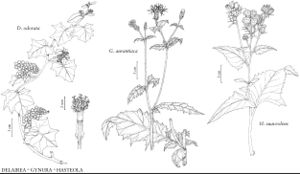Gynura
in F. Cuvier, Dict. Sci. Nat. ed. 2, 34: 391. 1825.
| Taxon | Illustrator ⠉ | |
|---|---|---|
 | Delairea odorata Gynura aurantiaca Hasteola suaveolens | Yevonn Wilson-Ramsey Yevonn Wilson-Ramsey Yevonn Wilson-Ramsey |
Perennials [subshrubs, vines], 20–100 [300+] cm (± velutinous or villous [hispid, puberulent, glabrous], hairs often purplish). Stems usually 1, weakly erect, spreading, or clambering (branched). Leaves [basal and/or] cauline; alternate; petiolate (petiole bases sometimes expanded, weakly clasping) or sessile; blades pinnately nerved, ovate or elliptic to rhombic [oblanceolate or lanceolate to linear], margins [entire or subentire] toothed [coarsely pinnate], faces velutinous to villous [glabrous, hispid, puberulent]. Heads discoid, usually in corymbiform or paniculiform arrays, sometimes borne singly. Calyculi of 3–8+ bractlets. Involucres cylindric to campanulate [urceolate], [3–] 8–12 [–15+] mm diam. Phyllaries persistent, [8] ± 13 in (1–) 2+ series, erect (reflexed in fruit), distinct (margins interlocking), linear, subequal, margins scarious. Receptacles flat, foveolate (knobby in fruit), epaleate. Ray-florets 0. Disc-florets [20–] 30–80+, bisexual, fertile; corollas yellow or orange to brick-red [purplish, ochroleucous, or white], tubes longer than funnelform throats, lobes 5, erect or reflexed, deltate to lanceolate; style-branches stigmatic in 2 lines, apices with (orange or reddish) ± filiform appendages (hispidulous, 1–2 mm). Cypselae ± columnar or prismatic, 5–10-angled or ribbed, glabrous [hairy]; pappi persistent or fragile, of 60–80+, white, smooth or barbellulate bristles. x = 10.
Distribution
Introduced; tropical Asia, Africa (including Madagascar), sw Pacific Islands, Australia
Discussion
Species ca. 40 (1 in the flora).
Some species of Gynura are important in the horticultural trade; abundant literature is accessible through gardening compendia.